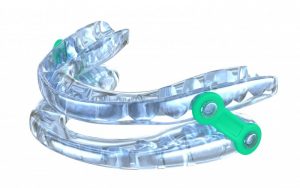4 Tips for Getting Used to Your Snoring Mouthguard
April 30, 2019

You have sleep apnea, and you know that you need to treat it so that you and your partner can get better, more restful sleep. Instead of a clunky CPAP machine, you decide to go with an oral appliance that you wear at night. And what’s more, you’ve even decided to get a custom mouthguard from a qualified sleep dentist to ensure that it fits comfortably and works properly. But on your first couple of nights wearing the appliance, you run into problems. Maybe it feels tight or uncomfortable, makes you drool, or makes falling asleep a little more challenging. Well, here are some ways to help you get used to your snoring mouthguard for sleep apnea treatment.
Find the Right Kind of Mouthguard
Even though oral appliances to treat sleep apnea and TMJ issues are still relatively new, there are tons of them available. Some are made to be worn on the bottom teeth, while others are fitted for the upper. Some only cover a few front teeth, which helps those who have a sensitive gag reflex. Others use very thin materials—the variations go on and on. Some potential brands that your dentist may recommend based on your specific situation include the following:
- MicrO2.
- Panthera.
- Narval by ResMed.
- The SUAD.
- Moses Appliance.
- Respire Pink.
- OASYS.
- Thornton Adjustable Positioner (TAP).
- Elastic Mandibular Advancement (EMA).
- SLEEP NITE.
- AveoTSD.
It may take some experimentation to find the right kind of mouthguard for you, so don’t give up!
Have Your Dentist Adjust Your Mouthguard
Although your custom mouthguard should fit your mouth properly, it may not be completely perfect. If it causes your teeth to feel sore or causes pain, call your dentist and ask them to make a few adjustments. They can make it feel more comfortable for an easier transition. However, feeling like your mouthguard is tight or just generally uncomfortable is completely normal. In fact, you want the mouthguard to be at least somewhat tight so that it stays in place during the night.
Keep Your Mouthguard Clean
Even if you adjust quickly to having a mouthguard in place, it doesn’t mean that it can’t become uncomfortable at a later date. That’s why you need to take care of your mouthguard. Just like your teeth, your mouthguard can accumulate plaque and bacteria over time. If you don’t rinse and gently brush your appliance on a regular basis, it can develop an unpleasant odor or discoloration from the bacteria. You may even want to consider soaking your mouthguard in denture cleaner to provide additional protection against buildup and bacteria.
Be Patient
It can take nearly a month to start and retain a new habit. If you consistently wear your mouthguard at night, eventually your brain will become familiar with how it feels in your mouth to the point where you won’t even notice it anymore. So give it some time, and don’t throw in the towel.
Change isn’t always easy, but you can adapt to it. Following these tips can help you reap sooner the benefits of treating your sleep apnea with an oral appliance. Pretty soon you’ll be waking up feeling refreshed and energized instead of exhausted.
About the Author
With many years of experience, Dr. Kent Smith is a Diplomate of the American Board of Dental Sleep Medicine and the American Sleep and Breathing Academy, of which he serves as president. For five years, he hosted a weekly radio show about sleep disorders called Pillow Talk. In addition, he wrote sleep curriculum for the Las Vegas Institute for Advanced Dental Studies. At Sleep Dallas, he offers all the brands of mouthguards listed in this post. To make an appointment with him, call his Irving or Frisco offices or click here.
